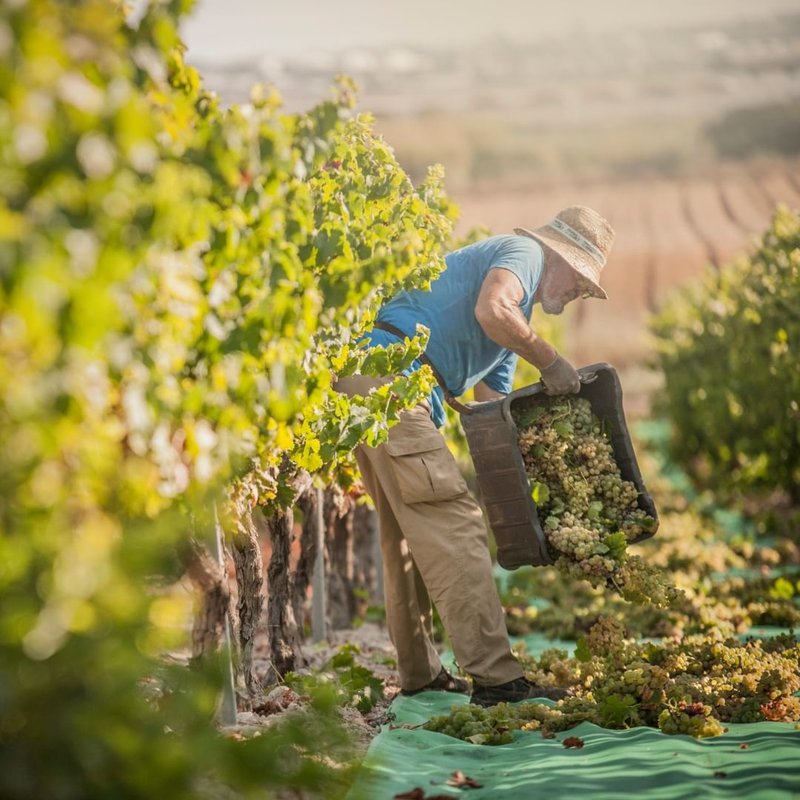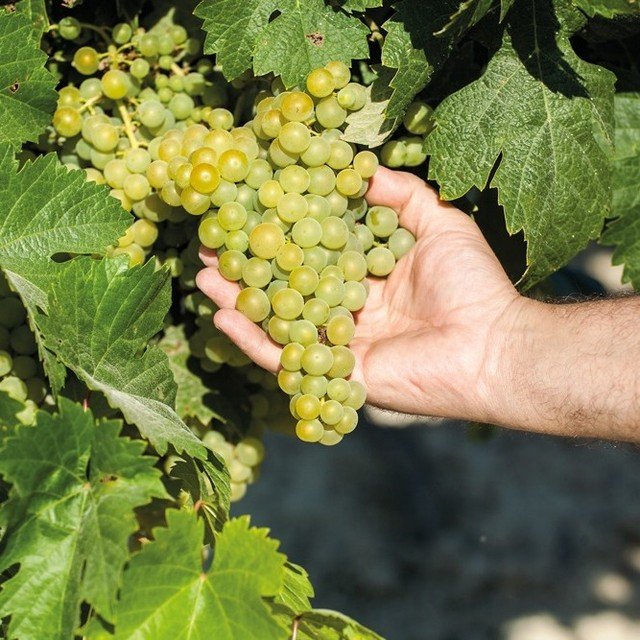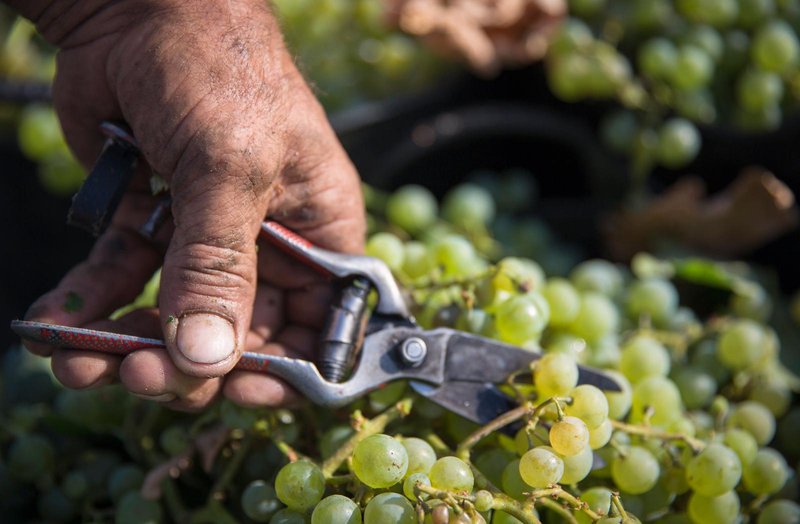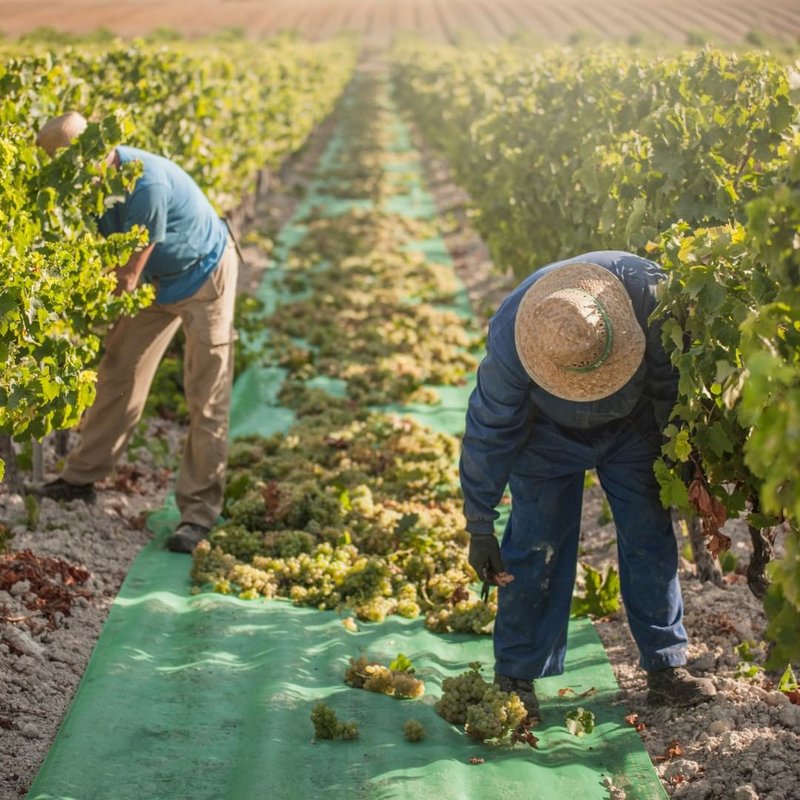
Within the Marco de Jerez region, wine plays an important economic, gastronomic and cultural role. Since the beginning of time, Sherry Wines have been as highly and widely valued a commodity as pure gold, the most precious perfume, and the most exquisite music; these wines have bestowed wealth, abundance and joy on this corner of south-western Spain. Thanks to the stamina of the grape-pickers, the skill of the foremen, the mastery of the venenciadores, and the dedication of the coopers, the arrumbadores (those who look after the botas), and the workers of the fields and bodegas, the ageing of Sherry Wine has become a ritual, with the highest standards of purity and quality.
At harvest time, Jerez smells of fiesta and must. The birth of the new wine serves as an occasion to glorify this unique territory - the Marco de Jerez. This is when the season’s yield is collected after a year of uncertainty, when everyone can stop casting anxious glances towards the sky, and can finally switch their attention to the liquid gold that, when the time comes, will be savoured in a glass.
What happens during the grape harvest in the Marco de Jerez?
To understand the importance of the grape harvest in this part of the world, we must go back to the origins of vine cultivation. The history of the Marco de Jerez is the history of its wines: the personality and versatility that define them are the result of the different cultures and civilisations - Phoenician, Roman and Arab - that have inhabited the region over the centuries.
We’re talking about the oldest wine-growing region in Spain. Here, vine cultivation and winemaking started more than 3,000 years ago. The unique climatic and geographical conditions of the area, the warm climate, the limestone terroir of white albariza, which millennia ago was covered by the ocean, and the westerly and easterly winds, together make the wines of Jerez unique and inimitable.
Between August and September, the grape clusters turn soft, golden, and sweet. This is the sign that the harvest is ready to begin, although the exact start date will depend on the decision of each winegrower.
This week, the first presses are getting ready to receive grapes from the earliest vineyards of the Marco, located in very specific inland vineyards. The first important presses in the Marco are expected to open over the course of the current week, and in the coming week (the second week of August) several more will join them, although in all likelihood harvesting activities will not begin until the second part of August.
Grape varieties in the Jerez Region
Palomino Fino: the essence of Sherry and Manzanilla Wines
Palomino Fino is the most traditional grape variety and the most abundant in the vineyards of the Marco de Jerez. Completely adapted to the terroir, it is not vulnerable to the various parasites, and for this reason its excellent quality and favourable behaviour make Palomino Fino the preferred variety for the winemaker and the vine grower alike. Queen of the south and the essence of Jerez wines, this white variety with its highly appreciated, juicy berries is also the only one used in the production of Manzanilla de Sanlúcar. The Palomino Fino grape, together with the proximity to the Guadalquivir river, creates the personality of this pale wine, with its intense aromas, which is dry, fresh and delicate in the mouth.
Pedro Ximénez: the sweetness that enriches the variety of Sherry Wines
The sweet grape that enhances the broad range of Sherry Wines has its own name: Pedro Ximénez (PX) is another of the region’s traditional grapes. Its high sugar content, boosted by a late harvest and subsequent exposure to sunlight, along with its high acidity levels, make it the ideal variety for the production and ageing of quality sweet wines.
Moscatel: the emblematic grape of Chipiona
As the emblematic grape of Chipiona, Moscatel de Alejandría is used to make extremely particular sweet wines. Moscatel wines proudly bear the name of this variety of African origin, which is widespread in many parts of the world and was mentioned in antiquity by Columella. This variety grows best in vineyards located near the sea and the grapes are sun-dried on mats next to the vines, producing concentrated, elegant and floral wines.

Preparing the vineyards for the harvest
In order for the grapes to reach the year’s most critical moment - the harvest - in the best possible condition, the winegrowers look after the vines painstakingly during the previous twelve months. Among the most crucial tasks that are carried out in the vineyard before the harvest, is the green pruning, known in the Marco as castra. This is a manual task that greatly influences the annual and overall development of the vine, and consists of eliminating unnecessary shoots that may compete with those that are genuinely useful for the plant.
In Jerez, the main pruning method is known as vara y pulgar (stick and thumb) or jerezana, and is traditional and specific to this designation of origin. This method consists of forming, from the trunk of the vine, two arms or brocadas, on which are left in alternate years, a vara (longer stem) of at least 8 buds and a pulgar (shorter stem) of 1 or 2 buds. The vara yields the year's crop, while the pulgar produces a bud which will become the following year's vara.
Tilling the land is another age-old practice through which the winegrower can control the production and quality of the grapes. The objective is twofold. Firstly, to retain and absorb as much rainwater as possible in the soil during the winter, and secondly, to conserve this soil moisture for the spring and summer, and thus alleviate the lack of water that often accompanies the high temperatures during this time of year.
It is also essential to ensure that the bunches are not completely exposed to the sun and that the leaves of the vines receive sunlight: the plant needs to carry out the physiological processes required to obtain quality grapes. This is achieved by aligning the rows of vines along trellises of two or more horizontal wires onto which the varas are tied, thereby supporting the vegetation.
Timing of the harvest: How to know if the grapes are ready to be picked
When does the grape harvest usually take place in the Marco de Jerez?
As mentioned above, there is no exact date for the beginning of the grape harvest, as it is usually determined by a combination of factors. Leading among these is the ripeness of the grapes, which must reach a minimum of 10.5 degrees baumé. Normally, the winegrower prefers to bring the date forward, fearing that untimely rain might affect the health of the grapes or even cause them to fall off the vine. The winemaker, on the other hand, relies on precise data such as the degree of acidity and the general state of health of the grapes. But in the end, the logistical aspects are the most critical. An operation of this magnitude requires a robust socio-economic structure for organising foremen, grape-pickers, transporters, winery staff and other related workers.
Harvesting the grapes
Winegrowers say that the right moment to harvest grapes is "when the green stalk of the vine turns dark and the grape surrenders". Whether the grapes are harvested by hand, which is the most common method in the Marco, or mechanically, it is essential that the grapes reach the press quickly to ensure optimum sanitary conditions. This aspect is extremely important, as the high temperatures in the area during the harvesting season (traditionally the first weeks of September) can cause oxidation of the must and even uncontrolled fermentation during transport.
To take the grapes to the press, plastic boxes with a capacity of around 18 kilos are used, stacked on top of each other so that the grapes are not damaged on the way. In recent years, the use of vehicles with small tippers (whose capacity is around 7,000 kilos) has become widespread, as these are able to enter the vineyards and transport the grapes quickly and hygienically to the presses. Another practice that is becoming increasingly common in the region is to harvest at night when temperatures are lower, so that the grapes arrive at the winery in optimum condition, and also so that the grape-pickers do not have to suffer the intense daytime heat while harvesting.

The grape pressing process
Before unloading at the winery, the grapes are weighed to check that the production limits per plot, as set for each year by the Regulatory Council, are not exceeded. Once deposited into the reception hopper, an auger system transports the grapes to the first operating unit, a crusher or destemmer, whose purpose is to extract the must by means of pressure, breaking the skin of the grape and releasing a fraction of must from the pulp. Destemming or separation of the stalk is optional and can be carried out totally or partially before crushing.
The paste resulting from this process is taken, together with the free-run must, to the extraction system where the must is obtained by means of pressure. Depending on the level of pressure, different musts are obtained: the so-called primera yema must, generally used in the production of finos and manzanillas, the segunda yema must, for the production of oloroso wines and, finally, a fraction called 'press must', which is not used in the production of D.O. wines.
Pressing of PX and Moscatel
The harvest of the varieties destined to produce sweet wines has special characteristics. While the essential factor with Palomino is that the grapes reach the presses quickly, Pedro Ximénez and Moscatel undergo a previous process in the vineyard called asoleo, or sun-drying. Bunches of these grapes are placed on esparto grass mats next to the vines so that the sun can dry them. At night, the grapes are covered to protect them from the dew. The duration of the sun-drying process lasts between 10 and 14 days, depending on the degree of ripeness preferred by the winegrower.

Fermentation of sherry wines and factors affecting fermentation
Without getting too technical, alcoholic fermentation is a natural biochemical process by which the sugars contained in the grape must are transformed into alcohol. This transformation is possible thanks to the action of a crucial fermenting agent: yeast.
The start of fermentation is usually activated by means of pies de cuba, a preparation of indigenous yeasts selected by the wineries themselves, whose aim is to control the fermentation process. After a week, the amount of untransformed sugars in the must has reduced considerably, slowing down the fermentation process. Over the following weeks, the last few grams of sugar will be transformed into alcohol.
The milder temperatures that accompany the arrival of autumn enable the decantation of dead yeast in suspension - the famous lees. As the temperatures drop, the lees fall to the bottom of the tanks, the fermented must gradually loses its initial turbidity, becoming an increasingly clean and transparent liquid. The magic of Sherry Wines has begun.
The Fiestas de la Vendimia in Jerez: when they take place and what they consist of
Jerez celebrates one of its most emblematic and unique festivals to mark the birth of the new wine, the Fiestas de la Vendimia, declared of International Tourist Interest.
The 75th anniversary of its first edition was celebrated in 2023. On these festive days to welcome the new vintage, wine is the protagonist of a full programme that includes master tastings, guided visits to wineries, and concerts, in addition to other activities such as the traditional Pisa de la Uva (treading of the grapes) or the popular Children’s Sherry Pouring Competition, which attracts a multitude of young enthusiasts every year.
To find out about the activities that will be held this year, see the programme of theFiestas de la Vendimia 2024.







